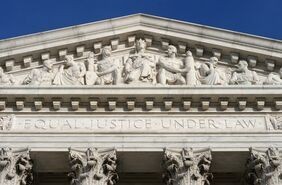Mediation of Construction (and other) Disputes: A Laundry List for Litigants and Advocates
Client Alert | 8 min read | 04.05.07
No more than 10% of all construction disputes are litigated or arbitrated to judgment. About 70% to 80% of all civil litigation/arbitration cases are, at some point, the subject of mediation. In short, settlement is the preferred and dominant manner of resolution of such disputes. With this in mind, here is a “laundry list” of things to bear in mind when approaching mediation.
- Avoid surprises. Make certain that your mediation brief is both comprehensive and specific on the salient points. Also, it will save time if the mediation brief specifically addresses insurance issues. It is best that the mediator have a firm grasp on the pertinent coverage and coverage issues (reservation of rights, etc.) BEFORE the actual mediation commences. Avoid “straw man” arguments. Much time is often lost in mediation while the mediator plays “detective.” Each side should have a good idea of what position(s) the other will take at the mediation. In that regard, the “confidential” mediation brief can be counterproductive. If you have some issue which you want only the mediator to be aware of, make it the subject of a separate disclosure. Remember, you are trying to settle, not win.
- Ensure that all parties necessary to effect settlement are present and have settlement authority. If an insurance carrier (or carriers) are going to be the ones who “show the money,” make certain empowered representatives are present. If possible, have them execute the agreement.
- Consider who the parties are and who will bear the financial brunt of any settlement payment. If an individual (as opposed to a large corporation or an insurance carrier) must fund the settlement, resolution is likely to be much more difficult. In this circumstance, the mediator must be particularly sensitive to this individual’s needs and issues.
- Some pre-mediation discovery is advisable. First, it will flush out the facts, so that the parties are not forced to deal with new discoveries and/or issues at the mediation. Second, it may “tenderize” the parties by making them aware of the projected costs of litigation. This is particularly beneficial if any party is a neophyte to litigation.
- File all motions (discovery, summary judgment, etc.) PRIOR to the mediation, but set them for hearing AFTER. These can become a bargaining tool.
- It may be preferable to allow the defendant(s) to propose the mediator. Since they will be the ones paying the money, they will feel more comfortable in that scenario, which could expedite settlement. In any case, look for a mediator who:
a. is energetic;
b. has a sense of humor (it actually can help create a more congenial atmosphere);
c. can develop a relationship with all the parties;
d. has experience in the area being litigated (construction cases invariably involve much industry specific folklore and expectations, which are not part of the documents);
e. treats all matters as being equally important (i.e., does not think the amount and/or issues in dispute are beneath him);
f. understands that his job is to bring about resolution, not to grind the parties to a fine pumice in order to achieve settlement; and
g. does not have his “eye on the clock” (most mediators charge a lump sum for a day and some think that day ends at 7 hours – get one who is willing to “stay the course”). - Check out the mediator. Ask for a list of attorneys who have used him recently.
- Consider using various media to present your case to the mediator (e.g., photos, presentation boards, videos, overhead projections and the ever-popular “PowerPoint”).
- Mediations typically begin with a joint session prior to breaking down into caucuses. During these joint sessions, each side will tell its story. It is important that this segment deal with specific “selling points” and not the entire story. If your brief has been thorough, everyone has a good idea of what the case is about. Long, tedious and repetitive openings are “energy vampires” and often exacerbate strained relations among the parties.
- Forget the Rules of Evidence. Mediation is not trial. Nothing is inadmissible. You are trying to make a point, not a record.
- California Evidence Code section 1152 makes inadmissible any offer to compromise. Similarly, section 1119 provides that anything said, and writings “made” for mediation are neither discoverable nor admissible. In Rojas v. Superior Court, 33 Cal. 4th 407 (2004), the California Supreme Court held that witness statements, reports, analyses test data and photographs made for mediation were not subject to disclosure via subsequent discovery. It is important to distinguish those items “made” for mediation and those simply “used.”
- Understand the relationship between California Evidence Code section 1123 and California Code of Civil Procedure section 664.6. While section 664.6 provides that a court may enforce a written settlement by morphing it to a judgment, section 1123 sets forth the requirements for a written settlement agreement made at mediation to be admissible. I have a “settlement template” on our system. When I mediate outside of the office, I carry it with me on a CD-ROM for downloading at the mediation site. However, no template can possibly foresee all the terms that the parties may want or need. At bare minimum, it must contain a waiver of California Civil Code section 1542 (assuming the parties wish to dispose of “all” claims, both known and unknown). Further, settlements are often arrived at after hours of negotiation. The parties and their lawyers are fatigued. This can lead to the omission of a significant aspect of the settlement. For this reason, I urge the parties to waive the mediation privilege in the settlement agreement. This will permit the court to hear testimony regarding the settlement and may permit it to enter judgment even where the written document is ambiguous.
Randall L. Erickson manages Crowell & Moring’s Irvine, California office. He is Chair of the firm’s Construction Practice Group, having 34 years of experience in the industry. He has participated in hundreds of mediations, both as an advocate and a mediator. He can be reached at (949) 798-1323 or www.mediating-usa.com.
LICENSE SUSPENSIONS: Business and Professions Code section 7145.5(a), amended effective January 1, 2007, provides that a contractor’s license may be suspended for failure to pay state income taxes or fees and penalties assessed by the Department of Industrial Relations, the Employment Development Department or the Contractors License Board. Of significant note is the fact that the suspension extends to personnel of record, who may not work in any supervisory position for any contractor. The suspension applies to any contractor that shares personnel of record with the delinquent contractor, subject to certain exceptions.
ALTERNATE WORKWEEK SCHEDULES: Wage Order No. 16-2001, which became effective January 1, 2001, provides that new alternative schedule elections must take place when the number of employees employed for a minimum of thirty days in a work unit increases by fifty percent or more over the number who voted to ratify the alternative workweek schedule. A group of construction workers sued their employer for overtime wages based on working an alternative work schedule of ten hours a day, four days a week. The employer held a ballot to approve the four 10-hour day alternative schedule in December 1999, but did not hold a new election after Wage Order No. 16-2001 became effective in 2001. The workers contended that the number of employees in at least one work unit had increased by more than the required 50% and that a new election was therefore required. The employer countered that Wage Order No. 16-2001 was invalid and, therefore, no additional election was required. Held: Wage Order No. 16-2001 was properly adopted and is valid. Small v. Super. Ct., No. G037041, 2007 WL 603064 (Cal. Ct. App. Feb. 28, 2007)
CAL/OSHA: A contractor was cited for violations associated with work performed by a subcontractor. The contractor petitioned the California Occupational Safety and Health Appeals Board for reconsideration, which was denied. On appeal to the California Court of Appeal, the contractor argued for the first time that the Board failed to consider as a threshold inquiry whether the contractor exercised “reasonable diligence,” and that failing to do so impermissibly held the contractor to a strict liability standard for violations by its subcontractor. Held: The contractor failed to timely raise the affirmative defense of “reasonable diligence.” Although the court did not address the question, the decision appears to imply that contractors are not strictly liable for violations caused by their subcontractors. Overaa Constr. v. Cal. Occupational Safety and Health Appeals Bd., 147 Cal. App. 4th 235 (2007).
MEDIATION: A trial court ordered parties to attend and pay for private mediation in a complex construction defect case. One party objected and refused to attend the mediation. Held: The court does not have inherent authority to force parties to attend and pay for private mediation over a party’s express objection. Such an order would be contrary to the voluntary nature of mediation and to the statutory scheme. Jeld-Wen, Inc. v. Super. Ct., 146 Cal. App. 4th 536 (2007).
PUBLIC WORKS: A subcontractor argued that, despite the fact that its bid included an offer to provide a bond if required, a contractor waived the right to demand a bond because the contractor did not prepare a written or published request for sub-bids under California Public Contract Code section 4108(c). Upon the subcontractor’s refusal to provide a bond, the contractor moved to substitute the subcontractor for failure to execute a written contract for the work. Held: Because the contractor did not prepare written or published requests for sub-bids, 4108(c) did not apply and the subcontractor was bound to its offer to provide a bond. Substitution of the subcontractor under California Public Contract Code section 4107(a)(1) was therefore proper. Golden State Boring & Pipe Jacking, Inc. v. Orange County Water Dist., 143 Cal. App. 4th 718 (2006).
C&M News:
- For the second year in a row, Randy Erickson was named a Super Lawyer by Los Angeles Magazine in the field of construction litigation. Mr. Erickson was also recently recognized among the world’s top lawyers in his field in The International Who’s Who of Construction Lawyers.
- Steve Rice received an Angel Award from California Lawyer magazine for his representation of pro bono clients over the past six years. Only sixteen attorneys throughout the state received this honor.
- In furtherance of Mr. Erickson’s thriving mediation/arbitration practice, he was recently certified by the State of California as an arbitrator for the Public Works Contract Arbitration Program. In addition, Mr. Erickson has been appointed to Dispute Resolution Boards for the following:
- San Francisco Bay Bridge Rehabilitation and Retrofit Contracts; and
- CATS (Caterpillar Construction Equipment) project in Charlotte, North Carolina.
- Deborah Arbabi and Queena Hu recently achieved a favorable settlement for a civil engineer on a construction defect litigation.
- Mr. Erickson and Christine Cwiertny reached a favorable settlement for a golf course developer on a subcontractor dispute.
- Crowell & Moring will be participating in the upcoming ABA Forum on the Construction Industry.
Contacts
Insights
Client Alert | 9 min read | 01.06.26
Beyond the Checkout: Retail's 2026 Legal Minefield
2026 will be a significant year for retailers and e-commerce companies, with significant changes on the horizon that will affect the entire industry and ecosystem. Potential headwinds and developments in product safety, pricing, artificial intelligence, data privacy, website compliance, and environmental responsibility are expected. But amidst these changes, there are likely significant opportunities that retail and e-commerce businesses can capitalize on.
Client Alert | 6 min read | 01.06.26
California Privacy Agency Launches Data Broker Strike Force Amid Delete Act Crackdown
Client Alert | 4 min read | 01.05.26
Another Court Rules CASA Does Not Limit Universal Relief Available Under the APA
Client Alert | 7 min read | 01.05.26
Consideration of Artificial Intelligence in Arbitration Terms of Reference



